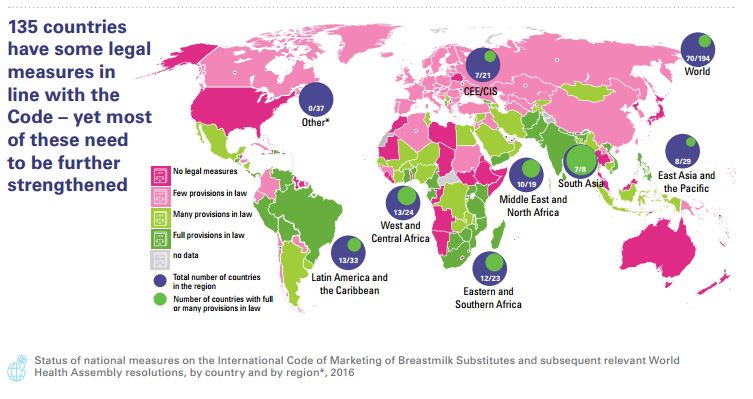New UNICEF report makes the case for breastfeeding and appropriate complementary feeding
In October 2016, UNICEF published a new report titled, “From the First Hour of Life: Making the case for improved infant and young child feeding everywhere,”. It provides a global status update on infant and young child feeding practices and puts forth recommendations for improving them. It features information on how infants and young children are being fed and how these feeding practices match up to the recommended guidelines on infant and young child feeding.
 In October 2016, UNICEF published a new report titled, “From the First Hour of Life: Making the case for improved infant and young child feeding everywhere,”. It provides a global status update on infant and young child feeding practices and puts forth recommendations for improving them. It features information on how infants and young children are being fed and how these feeding practices match up to the recommended guidelines on infant and young child feeding.
In October 2016, UNICEF published a new report titled, “From the First Hour of Life: Making the case for improved infant and young child feeding everywhere,”. It provides a global status update on infant and young child feeding practices and puts forth recommendations for improving them. It features information on how infants and young children are being fed and how these feeding practices match up to the recommended guidelines on infant and young child feeding.
Full Report | Key Findings Brochure
Children should be put to the breast immediately after birth, be breastfed exclusively for the first 6 months of life and continue to be breastfed after solid foods are introduced from 6 months to 2 years and beyond.
The report is divided into two parts: Part I focuses on breastfeeding and Part II looks at complementary feeding practices. Each part reviews the most recent evidence on infant and young child feeding practices and provides updated global and regional estimates and trends, where available, as well as disaggregated analyses.
The importance of breastfeeding
Breastmilk is more than just food – it is also a potent medicine that is tailored to the needs of each child.1 Exclusive breastfeeding, feeding infants nothing but breastmilk for the first six months of life, is the safest and healthiest option for children everywhere and has great potential to save lives. In low- and middle income countries, infants who received foods and liquids in addition to breastmilk before 6 months were up to 2.8 times more likely to die than their exclusively breastfed peers; the risk of dying was 14-fold higher among those not breastfed at all. In rich and poor countries alike, long periods of breastfeeding are associated with higher intelligence scores, and there is evidence that this translates into improved academic performance and long-term earnings. There is growing evidence that breastfeeding may also reduce the incidence of overweight, obesity and chronic diseases later in life.1 Low rates of breastfeeding are responsible for losses of more than $230 billion annually in high-income countries, and $70 billion annually in low- and middleincome countries.
The importance of appropriate complementary feeding
Starting at 6 months of age, children’s nutrient needs are greater than what breastmilk alone can provide. Feeding children solid, semi-solid or soft foods from 6 months of age is key to prevent deficiencies that could result in undernutrition. Diets that meet at least minimum frequency and diversity standards are essential to preventing micronutrient deficiencies, stunting and wasting. If appropriate complementary feeding practices were scaled-up to nearly universal levels, approximately 100,000 deaths in children under five could be averted each year.
 What do we need to do better to support breastfeeding?
What do we need to do better to support breastfeeding?
- Fully implement the International Code of Marketing of Breastmilk Substitutes and relevant World Health Assembly resolutions through strong legal measures that are enforced and independently monitored by organizations free from conflicts of interest.
- Enact family leave and workplace breastfeeding policies, building on the International Labour Organization’s maternity protection guidelines as a minimum requirement, including provisions for the informal sector.
- Implement the Ten Steps to Successful Breastfeeding in maternity facilities, including providing breastmilk for sick and vulnerable newborns.
- Improve access to skilled lactation counselling as part of comprehensive breastfeeding policies and programmes in health facilities.
- Strengthen links between health facilities and communities, and encourage community networks that protect, promote, and support breastfeeding.
- Create monitoring systems that track the progress of policies, programmes, and funding towards achieving both national and global breastfeeding targets.
 What do we need to do better to support complementary feeding?
What do we need to do better to support complementary feeding?
- Enact legislation and adopt policies in line with the Guidance on Ending the Inappropriate Promotion of Foods for Infants and Young Children to prohibit the inappropriate promotion of all commercially produced food or beverage products marketed as suitable for children up to 3 years of age.
- Select and combine multiple strategies and interventions that are evidence-based and informed by adequate situation analyses.
- Create a healthy and nurturing feeding environment within households and communities. Early childhood development interventions that stimulate and encourage responsive feeding should be integral to child nutrition programmes.
- Coordinate actions among key government sectors, including health, agriculture, water and sanitation, social protection and education.
- Harness the potential of the private sector to create food solutions and hold them accountable for complying with food production, labelling and marketing regulations.
- Create monitoring systems to track progress effectively. Governments need to collect credible and comprehensive data on infant and young child feeding, aligned with the standard global indicators.
Learn more about breastfeeding at UNICEF